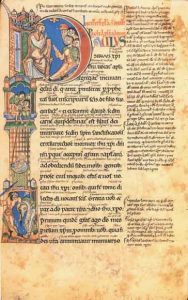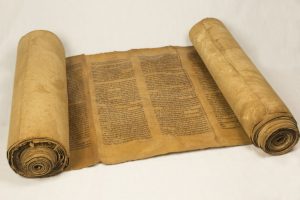“I am an ecclesiastical historian by training and a Bible software guy by trade. Which, I think, puts me in the unique position to write about the history of the intersection of technology and Scripture study in a series of posts.”

“We might start with a description of the Bible we are all used to. It is a stand-alone, printed volume of 73 books (give or take a few), with a more or less fixed text translated from the earliest and best manuscripts. Because of its size, its mass production, and the fact that nearly all of us are literate, we tend to think of the Bible as a self-contained work that is readily available and can be read by anyone and anywhere.
The Bible was a very different thing in the Middle Ages. That may seem like a bold statement, but let me explain.
Medieval Christianity was profoundly sacramental, focusing on an encounter with Christ that was both spiritual and physical.
As the theologians of the period frequently remarked, Christ was the Word of God in both His “doing and teaching” (Acts 1:1). For the medieval Christian engagement with the spoken Word of God was not divorced from physical engagement with Christ’s Body, and so the Bible was, above all else, a liturgical book.

-
Save
In the liturgy the Christian was understood as united vertically with God and horizontally with his fellow man—all together, the Body of Christ.
This was the context in which medieval Christians studied the Scripture. Indeed, they often evoked Eucharistic imagery. They “chewed” the Word and “swallowed” it. This was an act of deep reading and meditation on the text that culminated in memorization.
But they did not understand memorization as do we. We tend to think of the memory as a hard drive, and memorization as an act of rote drilling that leads to data retention. To the people of the Middle Ages, however, the act of memorization was that of “digesting” the Scripture so that it became a part of who they were.
Like how the Eucharist became a part of the body, the Scripture became a part of the mind. Amazing feats of memory are documented, such as being able to recite the Bible backwards……..
For the whole article, visit HERE.
For a very funny video on Scripture study in the Middle Ages, watch this. Switching technology from scrolls to codex (books). I had tears in my eyes I laughed so hard.
ANOTHER VERSION:



This Post Has 2 Comments
Interesting article. Most people in the Middle Ages couldn't read or write. To a great extent they relied on their priest for their information about the Word of God. a bit like in many churches today. Depending on the priest or maybe the Bishop their knowledge of the Word of God was good, poor or non-existent. A bit like today. No wonder Martin Luther caused such a stir in his day when he actually gave the people the Word of God in their own native tongue. No wonder the Catholic hierarchy were scandalize that they no longer had a monopoly on God and his Word. Not everyone knew Latin then but everyone could speak their own language just as Jesus had to his disciples.
STEVE RAY HERE: The problem with the above comment is that it is incorrect. The people were much smarter and literate than we suspect. There were public debates, etc. Another problem is that Catholic Church had already provided over 13 translations of the Bible in the language of the people; Luther was not the first. The Catholic hierarchy was not scandalized to have the Bible in the venacular; rather, it was like a mother who was jealous of her children being assaulted by heretical translations, annotations and interpretations.
The Medieval Help Desk was so funny that I had to find it on YouTube myself. Here is a clearer version of it with a few more of the subtitles present. https://youtu.be/pQHX-SjgQvQ
STEVE RAY HERE: Thanks Taryn, I added this version too. God bless. I thought it was hilarious too. No matter how many times I watch it I always laugh out loud.
Comments are closed.